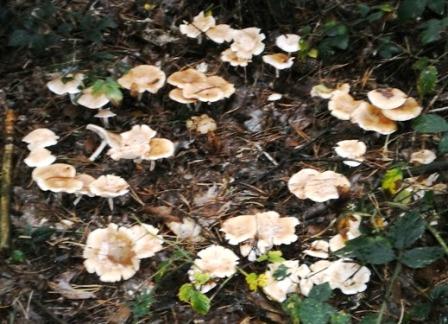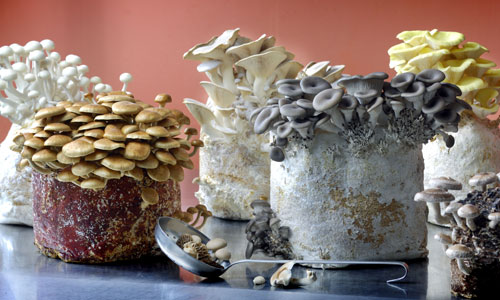Mushrooms are the fruit bodies of fungi who under the surface form a network of fine wires: the mycelium (or spawn). Fungi rooting by the soil with their wires that can fan out and form fairy rings. The largest mushroom circle is 880 hectares.
 In a single cubic centimeter of earth you can find over 780 meters mycelium cells. Your foot covers about 480 kilometers mycelium (according to Paul Stamets in May 2008 at TED: 6 ways mushrooms can save the world). Mushrooms have no chlorophyll. They can therefore not create their own nutrients through photosynthesis. Therefore they need to get them out of organic materials.
In a single cubic centimeter of earth you can find over 780 meters mycelium cells. Your foot covers about 480 kilometers mycelium (according to Paul Stamets in May 2008 at TED: 6 ways mushrooms can save the world). Mushrooms have no chlorophyll. They can therefore not create their own nutrients through photosynthesis. Therefore they need to get them out of organic materials.
The major part of his life, the fungus is just mycelium that grows through a substrate. The mushroom will appear only when the circumstances regarding nutrition, humidity, temperature and light are suitable. Each mold is specialized and thrives best on his favorite surface.
The mushroom can be compared with an apple. It is this fruit body that you harvest. But actually it takes an entire tree, branches, trunk and roots to grow. In fungi also, just this whole system is then almost invisible beneath the ground. Wanna harvest mushrooms, you must grow mycelium.
If you use straw, it must be organic straw. In large-scale agriculture the probability that there are fungicides used is super wide! Obviously there is no fungus more to grow.
Paint and stain have a very bad effect on the growth of the mushrooms, so use untreated wood and containers.
The first (brown) mushrooms were accidentally discovered in 1650 at melon farms in Paris, where they grew spontaneously on the waste (melons and leaves).
Mushrooms are propagated through a pure culture of mycelium on (cooked) grain, the "spawn” that is mixed in or grafted onto its host: straw, compost, sawdust, chips...
In a similar way on organic material to grow:
 Shaggy ink cap (Coprinus comatus): elongated egg-shaped hat with scales. The plates are white at first, but become liquefy and dripping black. In young, closed form a delicious taste.
Shaggy ink cap (Coprinus comatus): elongated egg-shaped hat with scales. The plates are white at first, but become liquefy and dripping black. In young, closed form a delicious taste.
Parasol mushroom (Macrolepiota procera): large, bright hat with brown scales and a blunt hump, nutty flavor and aroma.
Shiitake (Lentinus edodes): frequently bred, strong, smoky flavor, easy to dry.
Wood blewit (Lepista nuda): dense meat, young hats purple with purple plates.
Meadow mushroom (Agaricus campestris): white hat with pink to brown plates.
White button (Agaricus bisporus): common cultivated mushroom.
The growing process of this champignon takes about six weeks. In advance is in about two weeks compost produced. The compost consists of lime, horse manure and chicken manure.
You can make compost with pasteurized (cooked at 55°C) or fresh straw to avoid cross contamination with other fungi. Moisturize regularly and turn every 5 days until the straw became brown and crumbled. If there is no smell of ammonia is expelled any longer, the substrate is ready to put in bins where it needs to cool down to ± 24° C. Then you can graft spawn: divide and spread it and cover with the compost. Keep the soil moist (not wet) and dark, covered.
After a two weeks you will see numerous grayish threads appear, which will coalesce into a more fibrous mycelium from which the mushrooms will get along.
In grown trough compost no fruiting bodies can form. Therefore, one covers the compost with a layer of 4-5 cm, consisting of peat, or a mixture of 80% peat and 20% marl or earth foam (a waste product of the sugar industry) to bring the acidity on level.
The covering soil ensures that the humidity and temperature does not fluctuate too much and acts during cultivation as a water buffer.
The bacteria that live in the casing stimulate the mycelium to form mushrooms. Without these bacteria, there are also no mushrooms. Therefore, mushrooms can only be grown with compost in combination with casing soil.
If the casing is well as fully colonized with mycelium, the grow room is intensively ventilated. This lowers the compost temperature and carbon dioxide content. This stimulates the mycelium in the casing to the formation of fruit bodies.
Depending on the breed species a temperature between 16 and 22°C is maintained.
+ 24°C during composting, to 24° C for the growth of the mycelium, 17°C (surrounding 18 to 20°C) in the growth of the fruit bodies at a relative humidity of 90% (in dark surroundings).
A growing bed has about three to four (always smaller) ‘flushes’ or harvests with an average duration of 3 weeks per flush.
Picking is done with a rotary motion. With the hand 15 to 18 kilograms of mushrooms may be harvested per hour.
The north side of a building or wall is not productive for plants, but ideal for mushrooms on wood or straw. Moist and shaded is an ideal environment for them.
Species that are grown on wood:
Bearded tooth (Lion man,..) (Hericium erinaceus) waterfall of icicle like spines, soft, sweet flavor.
Nameko (Pholiota nameko) delicious Japanese mushroom with orange brown hat.
Velvet Foot (Flammulina velutipes): is grafted onto sawdust and malt.
Stinkhorn (Phallus impudicus) (still in egg shape) is grafted onto sawdust and sugarcane.
Sulfur shelf (chicken of the wood) (Laetiporus sulphureus) yellow consoles, flavor and structure of chicken meat.
Oyster mushroom (Pleurotus ostreatus) large, often cultivated oyster shaped mushroom, is grafted on pasteurized wheat straw.
Shiitake: is grafted on (sawdust of) hardwood, lasts one year, harvest is up to 5 years.
Do not use softwood, just hardwood (for this and most species). Also no fruit, but beech, hazel, chestnut, maple, birch, as stem, sawdust or chips.
Take not old wood, which is probably already colonized by other fungi, even though you do not see them. The best pieces come of a newly fallen tree that you let dry for a while. So use either a free fresh coppice block, which has not yet been infected or colonized. Saw of a parent lug at least one disc of the potentially infected top and bottom off.
Shiitake has a preference for oak.
Some species, such as the oyster mushroom, are less picky.
Oyster mushrooms are called delicate. Frequent handling, can disintegrate or cracks the clusters.
Trunks of 5-15 cm diameter, that are cut down in the resting stage, are seeded in the spring. The spawn is sold in dowels (wooden plug).
Drill every 15 to 20 cm around with a drill bit that is 0.5 or 1 mm wider than the dowel, holes into the core of the stem. Count on at least 30 dowels for a colony of 100 cm x 15 cm. Hold the drill firmly, the drill retracts into the green wood. Unless you have a special drill for wet wood. Tap the dowels into the holes with a hammer.
Use beeswax, cheese wax or dowels to seal the holes against drying and insect damage.
The logs are kept warm and humid while the mycelium colonizes the wood. It may take 6 months to +12 for fruiting begins, which can go up to 5 years. Harder woods such as oak and beech need more time.
You can also mingle bags with moist sawdust or cooked wood chips of untreated wood with brood (spawn) and keep it in a warm place while the mycelium grows. Then you put them in a light, cool place for the production of mushrooms.
There are different types of mushrooms in the trade for sale in boxes and bags with grown mycelium for hobby growers. Watering, following the instructions and have patience is enough to harvest.
To make your own dowels soak them first and boil to make the wood moist and sterile. Then leave to cool in a clean bag, along with grafted dowel or straw containing mycelium. Keep the bag or pot moist and dark with the open bottom down (against infection and drying). After about a month they are ready.
The hard slate bolete (Leccinum duriusculum) is a tasty and (4°C) well storable mushroom that also can be grown. But you have to wait at least 10 years for fruit.
(See also <Molds>)
